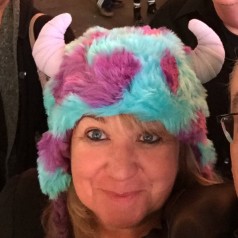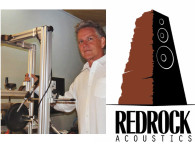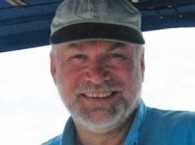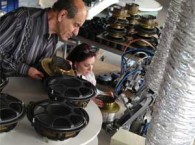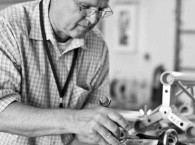SHANNON BECKER: What compelled you to start your company, SBS Designs, in 2011?
CRAIG BERNABEU: I was not really seeing audio products designed for a variety of applications with different approaches to record or play back music that would suit my needs. So in late 2009/2010, the former head engineer from Summit Audio and I started designing visionary gear. SBS designs makes my vision of US-made high-end designs with a left-field approach available to users.
SHANNON: How did you choose the name SBS Designs?
CRAIG: I have a sound company called SBS that designs custom high-end analog systems for different venues. SBS Designs builds custom speaker cabinets, consoles, and desks for mixing consoles and outboard gear. I had originally planned to call the company SBS Electronics. Due to legal trademark issues I could not use the name so I came up with SBS Designs, which works perfectly. SBS is globally known for the systems I have designed in the past so I wanted to incorporate the name into my new business venture.
SHANNON: Tell us about your company’s first product.
CRAIG: Our first product is the Iso-Q2, which is a three-band program equalizer with infinity cut, 15 dB of boost with five front controllers, three gain controls and two adjustable frequency potentiometers for the low and top end. Its I/O is balanced and unbalanced with a selectable effects loop. The Iso-Q2 is 115 and 230 V ready. It also offers a rear-panel output gain trim for perfect gain matching or it can be used to reduce gain for heavy-handed end users.

The Iso-Q2 is a solid-state three-band isolator/three-band program equalizer with five usable front panel controls (top). The Iso-Q2 can be used in an effects loop insert, mixbus, or main output of any console (bottom).
The Iso-Q2 enables the end user to sweep the low frequencies from 50 to 400 Hz with a front panel potentiometer. The high frequency is sweepable with another front panel potentiometer from 3.15 to 12.6 kHz, and it offers a frequency response from as low as 8 Hz to 100 kHz.
It’s primarily used in recording studios, and mastering houses; as live PA for mix engineers, electronic dance music (EDM) performers, and DJs performing in clubs or at festivals; or for sound reinforcement.
This Iso-Q2 can also be used as a performance processor to cut and boost on the fly, cutting out and isolating target frequencies from a song to get an audience excited in a live venue to take the energy to the next level. In the studio, the Iso-Q2 is intended as a program equalizer to sweeten up the source or equalize rough frequencies that need to be smoothed out.
SHANNON: What other products have you developed?
CRAIG: The SP-1 is the company’s first tube processor. The SP-1 is a unique design, offering features and technology that has not been previously developed. It is designed to warm up and improve the dynamic range. The SP-1 is a handmade hi-fi processor that will let you record and add dimension to music in ways never achieved.

The SP-1 tube device has two front-panel controls (top). The SP-1 offers a line level to phono level playback with a reverse phono curve to a line level source (bottom).
With the SP-1, I wanted to put a twist on vacuum tube processing. From the original concept, it took more than five years to get it perfect. We designed a few different concept prototypes and then put the prototypes through years of testing in different applications including live, studio and even home hi-fi applications.
There were a few things with the prototype that I did not like, so I started redesigning it and our engineering experts said I was crazy, and that no company would put this kind of R&D into one product. We spent thousands of hours on the SP-1.
That’s what is different about SBS Designs. The product needs to be right and very unique so it really stands out. So we went back to the drawing board and made multiple changes until it was perfect. Now, the SP-1 is my vision of what it should be.
What is really unique about the SP-1 is its reverse phono curve option, which is a first of its kind of feature with full control with the front panel controls. The SP-1 offers a phono stage to use with turntables for end users who want to get the most from vinyl to sample.
I wanted to include a feature that enables users to put phono curves on line sources to attain digital or analog line sources as close as possible to the sound of turntables. It is really amazing how good you can get line digital sources to sound.
SHANNON: Can you share some of the other challenges involved with the designs?
CRAIG: One major challenge is coming up with unique designs to put a twist on audio by offering features not previously done or different to the last design I have already brought to the market. But the biggest challenge with this philosophy is offering features for the end user but not at the expense of the sound quality.
To ensure this process properly works, I design my products two or three years before they are available to the public. Then I can really test them in a variety of applications so I know they work how I intend them to and sound the way I expect. This is very tricky to do, especially when I need SBS Designs to have perfect synergy with other high-end brands.
I have never approached any SBS Designs product with the idea that it will be like anything else on the market. I have always wondered what I could do differently than others to get the most out of the source and give users innovative options that are fun to use. I want to bring the fun factor back to recording or playing back music.
SHANNON: What makes your amplifiers unique?
CRAIG: The S-series amplifiers, which range from the S1 to the S6, are uniquely designed with a high-end old-school approach. Attention to detail is our first priority. Everything from the board layout and circuit design to all the components on the board, right down to the heatsink and manufacturing, are made to our specifications so the amplifiers sound and reproduce amazingly.
Our head of engineering and I are sticklers about this. If it doesn’t sound and function a certain way, it does not get released no matter how long it takes to get done. I don’t operate with time restrictions just to rush it and get it out the door. If it’s not right, it does not leave the facility.
So I think what makes us different is that we ensure our products are the way we want them to be throughout the entire process. This attention to detail is understood day one.
This especially applies with our ratings. We don’t play the ratings game just to show impressive numbers and have our products fall short of their specifications or go with the 1/8 duty cycle rating like most amplifiers do. Our S1 and S2 amplifiers offer 50% true duty cycle full output loads at full frequency from 10 Hz to 100 kHz and the same goes for the way we specify our larger S3, S4, S5, and S6 amplifiers.
We also decided to offer two high-current amplifiers. The S5 is a pure Class-AB, 2-Ω stable amplifier. The S6 is a Class-AB +B that is 2 Ω stable and designed to work flawlessly with 2-Ω load-driven hard and passive speakers with difficult chokes. In these applications, the S5 and the S6 would work perfectly and sound amazing.
SHANNON: How has the audio community reacted to your products? Is the audio market a difficult one to enter?
CRAIG: The community has been very receptive to SBS Designs. I have received several compliments and our products have been selling globally.
It seems the audio community is really enjoying the twist I have been putting on audio by adding different features to get the most from a mix or a sound system and providing really high-quality sound, which allows the end product to be improved whether it is live or studio recordings.
It’s been great so far with a lot of successful engineers and producers getting behind SBS Designs with great results on a production or in a live application.
The S5 is used in several mastering studios and receiving praise from engineers such as Nick Moon at Tone Proper Mastering in Oregon. Moon is using the S5 on the road to mix and he recently used the S5 to mix Liv Warfield when she performed on the Late Night with Jimmy Fallon show (http://sbsdesigns.com/liv-warfield-mixed-on-the-jimmy-fallon-show-s5-amp). So the S-series amplifiers are really getting incredible praise and demand is growing as SBS Designs’s reputations spreads.
The audio market, as with any market, can be difficult when you offer a left-field approach so it can take a while to make an impact. But, if you’re determined, you can make it happen, and it will.
SHANNON: Tell us a little about your background. What did you do prior to starting SBS Designs?
CRAIG: I went to school in the 1980s in New York City and got a degree in recording. I worked in a few studios then I started focusing on high-end analog pro sound system designs. They sold globally via word of mouth, and my sound system designs won or were nominated for best sound system times from 2003 to 2011.
I also built studio reference systems and worked closely with many major manufacturers and their engineers to change their products to structure them to meet my needs.
After several years, I noticed some of the great audio components be replaced by cheap products. I decided to design my own high-end products and I came up with a concept for an entire line.
I approached Summit Audio with my concept and they were interested. The first product, a tube processor that took two years to develop, was released in 2002. Next, we developed the amplifiers and then a solid-state equalizer. I also became an investor in Summit Audio in 2004.
After working with Summit Audio, Summit’s former head engineer and I started developing an entire new line. That’s when I started SBS Designs. SBS Designs are now sold in retail outlets in the US and a few countries around the world. It is growing fast and amazing things are happening for SBS Designs in 2014.
SHANNON: What’s next for your company?

The SP-1 PRO includes seven usuable front panel controls (top) and it can be used in any fully balanced or unbalanced circuit without any drive loss (bottom).
CRAIG: I have been working on my 2015 products for the last year and a half. My background is speaker design, and I have completed a full monitor line that I would eventually like to release.
For 2014, SBS Designs has two new designs—the SP-1 PRO and the SX-3. The SP-1 PRO is our second vacuum tube processor. It will feature seven front-panel usable controls, designed to really let the end user improve the dynamic range of any full-range source.
Similar to the SP-1, a carefully designed expansion process will bring out exciting detail that is so often masked by recordings that are compressed and engineered to be mono compatible. The SP-1PRO will also bring back incredible detail to digitally stored/processed recordings that were subject to data reduction processing.
SP-1 PRO also has a sub bass expander and an extended range of top treble expander. These expanders are top quality fully analog that don’t contain any noise or distortion generators. They add dynamic range by controlling the target frequencies with photoresistors.
When bringing a second vacuum tube processor to market, I had to be creative and provide features not previously used to help the end user receive more from the vacuum tube technology. (More information about the tube technology is available at www.sbsdesigns.com.)
In late 2014, we will release the SX-3, a two-way, three-way dual mono stereo analog crossover or a four-way mono. As with my other designs, I put a spin on it that you just don’t see on other crossovers, especially in the analog domain.
SHANNON: Do you have any advice for audioXpress readers who want to build their own sound systems?
CRAIG: Learn the importance of the physics of a cabinet design for a loudspeaker. Do not think you can build a speaker just any way and make corrections in the processing. This is a huge misconception in proper loudspeaker design.
Try to learn how to design a speaker so it can naturally reproduce music with as little processing as possible. Overprocessing seems like the norm these days, but the best, most amazing sound is the least processed with as little crossover points possible. A good speaker system effortlessly works with the least amount of gear in the signal chain and provides great results.
Before beginning a loudspeaker design, truly understand an amplifier’s specifications not just the watts per channel. Learn the Thiele-Small (T-S) parameters of a loudspeaker. Knowledge of room acoustics is also ultra important so there are no weak links in the chain. That way the end result will deliver as promised and maybe even more than promised.




